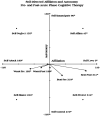Self-directed affiliation and autonomy across acute and continuation phase cognitive therapy for recurrent depression
- PMID: 15548462
- PMCID: PMC1282453
- DOI: 10.1207/s15327752jpa8303_07
Self-directed affiliation and autonomy across acute and continuation phase cognitive therapy for recurrent depression
Abstract
Using Benjamin's (2000) Structural Analysis of Social Behavior, we evaluated change in "self-directed" affiliation and autonomy and prediction of treatment response and relapse/recurrence among adult outpatients with recurrent major depressive disorder consenting to acute phase cognitive therapy (A-CT; Beck, Rush, Shaw, & Emery, 1979; N=156); A-CT responders randomized (N=84) to 8 months of continuation phase cognitive therapy (C-CT; Jarrett, 1989; Jarrett et al., 1998; Jarrett & Kraft, 1997) or assessment-only control; and C-CT and control patients entering a 16-month, assessment-only follow-up (N=74). Self-directed affiliation and autonomy increased after A-CT, and C-CT further increased affiliation and autonomy. Affiliation and autonomy did not predict A-CT response, but lower affiliation and higher autonomy pre-A-CT predicted relapse/recurrence post-A-CT. We discuss potential clinical implications of these results and present case examples to illustrate patterns of change.
Figures





Similar articles
-
Relational measures in psychotherapy research on process and outcome: a commentary on the studies.J Pers Assess. 2004 Dec;83(3):248-55. doi: 10.1207/s15327752jpa8303_08. J Pers Assess. 2004. PMID: 15548463 Review.
-
Deterioration in psychosocial functioning predicts relapse/recurrence after cognitive therapy for depression.J Affect Disord. 2009 Jan;112(1-3):135-43. doi: 10.1016/j.jad.2008.04.004. Epub 2008 Jun 9. J Affect Disord. 2009. PMID: 18539337 Free PMC article. Clinical Trial.
-
How much cognitive therapy, for which patients, will prevent depressive relapse?J Affect Disord. 2008 Dec;111(2-3):185-92. doi: 10.1016/j.jad.2008.02.011. Epub 2008 Mar 21. J Affect Disord. 2008. PMID: 18358541 Free PMC article. Clinical Trial.
-
Continuation-phase cognitive therapy's effects on remission and recovery from depression.J Consult Clin Psychol. 2009 Apr;77(2):367-71. doi: 10.1037/a0015238. J Consult Clin Psychol. 2009. PMID: 19309197 Free PMC article. Clinical Trial.
-
A lifetime approach to major depressive disorder: The contributions of psychological interventions in preventing relapse and recurrence.Clin Psychol Rev. 2015 Nov;41:16-26. doi: 10.1016/j.cpr.2015.02.003. Epub 2015 Feb 26. Clin Psychol Rev. 2015. PMID: 25754289 Review.
Cited by
-
Multiple measures, methods, and moments: a factor-analytic investigation of change in depressive symptoms during acute-phase cognitive therapy for depression.Psychol Med. 2005 May;35(5):693-704. doi: 10.1017/s0033291704004143. Psychol Med. 2005. PMID: 15918346 Free PMC article.
-
The effects of cognitive therapy versus 'treatment as usual' in patients with major depressive disorder.PLoS One. 2011;6(8):e22890. doi: 10.1371/journal.pone.0022890. Epub 2011 Aug 4. PLoS One. 2011. PMID: 21829664 Free PMC article.
-
Changes in cognitive content during and following cognitive therapy for recurrent depression: substantial and enduring, but not predictive of change in depressive symptoms.J Consult Clin Psychol. 2007 Jun;75(3):432-46. doi: 10.1037/0022-006X.75.3.432. J Consult Clin Psychol. 2007. PMID: 17563160 Free PMC article. Clinical Trial.
References
-
- Alpher VS. Identity and introject in dissociative disorders. Journal of Consulting and Clinical Psychology. 1996;64:1238–1244. - PubMed
-
- Diagnostic and statistical manual of mental disorders. 4th ed. Author; Washington, DC: 1994.
-
- Beck AT, Rush AJ, Shaw BF, Emery G. Cognitive therapy of depression. Guilford; New York: 1979.
-
- Beck AT, Steer RA, Garbin MG. Psychometric properties of the Beck Depression Inventory: Twenty-five years of evaluation. Clinical Psychology Review. 1988;8:77–100.
-
- Beck A, Ward C, Mendelson M, Mock J, Erbaugh J. An inventory for measuring depression. Archives of General Psychiatry. 1961;4:561–571. - PubMed
Publication types
MeSH terms
Grants and funding
LinkOut - more resources
Full Text Sources
